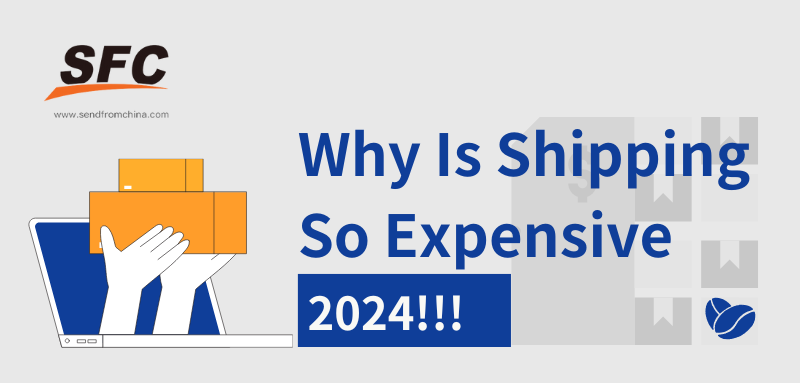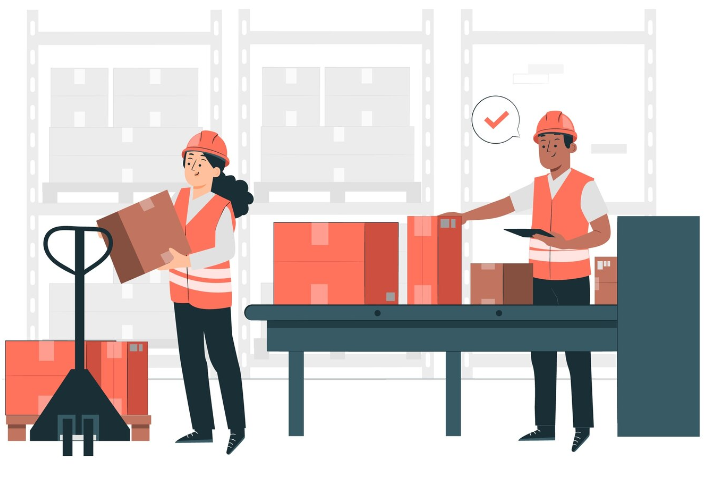Table of Contents
Why Is Shipping So Expensive 2024
Time: Jan 22,2024 Author: SFC Source: www.sendfromchina.com
Shipping costs have risen after the COVID-19 pandemic and most e-commerce companies are trying to control shipping costs. This surge affects not just businesses but also consumers, leading to an increase in the overall cost of shipping goods, while the shipping costs rise, the sale price also follows.
But what factors contribute to this rise? Let’s dive in and explore.
But what factors contribute to this rise? Let’s dive in and explore.

1. Reasons Why Shipping Is So Expensive
The COVID-19 pandemic significantly impacted global shipping costs, primarily due to disruptions in the supply chain. As the pandemic spread, governments around the world imposed lockdowns and restrictions to control the virus. This led to the closure of factories and reduced manufacturing output, especially in China, causing delays in the production and shipping of goods. Ports also faced operational challenges due to health and safety measures, leading to delays in cargo handling and a backlog of shipments. The sudden disruption in supply chains created a mismatch between the availability of shipping capacity and the demand for goods, resulting in increased shipping costs.
Another factor contributing to the rise in shipping costs was the surge in consumer demand, particularly for e-commerce. With more people staying at home, there was a significant shift towards online shopping, increasing the demand for goods to be shipped globally. This rise in demand coincided with the reduced availability of shipping capacity due to disruptions in the supply chain, leading to a classic supply and demand imbalance. Shipping companies faced higher operational costs, including the need for additional safety measures and staffing challenges, which were often passed on to consumers in the form of higher shipping rates.
Moreover, the pandemic led to specific logistical challenges, such as container shortages and port congestion. Many shipping containers were left stranded in ports that were not their final destinations, causing a shortage in key exporting regions like China. This scarcity of containers further drove up shipping costs. Additionally, port congestion, partly due to health and safety measures and increased import volumes, resulted in slower turnaround times for ships. These factors combined create significant inefficiencies in the global shipping network, further escalating shipping costs during the pandemic.
Another factor contributing to the rise in shipping costs was the surge in consumer demand, particularly for e-commerce. With more people staying at home, there was a significant shift towards online shopping, increasing the demand for goods to be shipped globally. This rise in demand coincided with the reduced availability of shipping capacity due to disruptions in the supply chain, leading to a classic supply and demand imbalance. Shipping companies faced higher operational costs, including the need for additional safety measures and staffing challenges, which were often passed on to consumers in the form of higher shipping rates.
Moreover, the pandemic led to specific logistical challenges, such as container shortages and port congestion. Many shipping containers were left stranded in ports that were not their final destinations, causing a shortage in key exporting regions like China. This scarcity of containers further drove up shipping costs. Additionally, port congestion, partly due to health and safety measures and increased import volumes, resulted in slower turnaround times for ships. These factors combined create significant inefficiencies in the global shipping network, further escalating shipping costs during the pandemic.
2. Key Factors Driving Up Shipping Rates
Several factors impact shipping rates, and these can vary depending on the mode of transport (sea, air, land), the type of goods being shipped, and current global economic conditions. Key factors include:
Fuel Costs
Fuel costs are a crucial factor impacting shipping costs due to their direct influence on the operational expenses of shipping vessels. Whether it’s for ocean freight, air cargo, or overland transportation, fuel is a fundamental necessity for the movement of goods. The price of fuel can be volatile, and fluctuate due to various global economic factors, including oil production levels, geopolitical tensions, and changes in energy policies.
When fuel prices rise, the cost of operating cargo ships, aeroplanes, and trucks increases significantly. This added cost is often passed on to consumers in the form of higher shipping rates, as carriers seek to maintain profitability.
When fuel prices rise, the cost of operating cargo ships, aeroplanes, and trucks increases significantly. This added cost is often passed on to consumers in the form of higher shipping rates, as carriers seek to maintain profitability.
Demand and Supply
Demand and supply dynamics play a fundamental role in shaping shipping costs, driven by the principles of the market economy. When there is a high demand for shipping services, but the supply (availability of shipping capacity) is limited, the cost of shipping naturally increases. This demand can be influenced by various factors, such as global economic growth, consumer trends, and seasonal demand.
For instance, during peak shopping seasons like the holidays or events like major product launches, demand for shipping services spikes. If the shipping industry cannot expand its capacity quickly enough to meet this surge, the limited space on ships, planes, and trucks becomes more valuable, and carriers can charge higher rates.
For instance, during peak shopping seasons like the holidays or events like major product launches, demand for shipping services spikes. If the shipping industry cannot expand its capacity quickly enough to meet this surge, the limited space on ships, planes, and trucks becomes more valuable, and carriers can charge higher rates.
Distance and Route
Longer shipping distances naturally require more time, fuel, and resources, which increases the operational costs for carriers. These costs are often reflected in the shipping rates charged to customers. For example, shipping goods across continents or around the globe is inherently more expensive than domestic or short-sea shipping due to the greater distances involved. The longer the journey, the more fuel is consumed, and the higher the costs for wear and tear on the transport vehicles, whether they are ships, planes, or trucks.
Type and Size of Cargo
The nature of the cargo significantly affects shipping rates. Fragile, hazardous, or perishable goods often cost more to ship due to special handling and storage requirements. The size and weight of the cargo also play a role, with larger and heavier shipments typically costing more.
Seasonal Variations
Certain times of the year, like the holiday season, see increased demand for shipping, which can drive up rates. Conversely, during off-peak seasons, rates may decrease.
Insurance Costs
The cost of insuring cargo depends on the value of the goods and the perceived risk of the shipping route. Higher risk or more valuable cargo can lead to higher insurance costs, which are factored into shipping rates.
3. How to Reduce Shipping Costs

Reducing shipping rates can be approached from various angles, both from the perspective of a shipping company and from that of a business or individual shipping goods. Here are some strategies:
Optimize Packaging
Optimizing packaging is an effective method to reduce shipping costs, primarily due to the way shipping rates are calculated. Most carriers determine shipping costs based on either the actual weight or the dimensional weight of the package, whichever is greater. Dimensional weight is calculated based on the package's size, length, width, and height.
By reducing the size and weight of the packaging, you effectively lower the dimensional weight, which can lead to significant savings, especially for businesses that ship large volumes of products. Compact packaging means more items can be shipped at once, maximizing space and reducing the number of shipments required.
By reducing the size and weight of the packaging, you effectively lower the dimensional weight, which can lead to significant savings, especially for businesses that ship large volumes of products. Compact packaging means more items can be shipped at once, maximizing space and reducing the number of shipments required.
Add More Local Warehouses
Adding more local warehouses is a strategic approach to reducing shipping costs, primarily because it shortens the distance between the product and the customer. When items are stored closer to the end consumer, the delivery route is significantly shortened. This reduction in distance directly translates to lower transportation costs. Shorter routes mean less fuel consumption and lower expenses on vehicle maintenance, which are substantial factors in shipping costs.
Furthermore, local deliveries often allow for the use of smaller, more fuel-efficient vehicles rather than larger trucks, which are more expensive to operate. This proximity also enables more frequent and flexible delivery schedules, further optimizing logistics and reducing costs associated with long-haul transportation.
Furthermore, local deliveries often allow for the use of smaller, more fuel-efficient vehicles rather than larger trucks, which are more expensive to operate. This proximity also enables more frequent and flexible delivery schedules, further optimizing logistics and reducing costs associated with long-haul transportation.
Outsourcing To A 3PL (Third-party Logistics) Company
Outsourcing logistics to a Third-Party Logistics (3PL) company can lead to substantial reductions in shipping costs due to economies of scale and specialized expertise. 3PL providers typically handle logistics operations for multiple businesses, allowing them to negotiate better rates with carriers due to their high volume of shipments. This collective bargaining power means they can secure lower transportation rates than individual companies might achieve on their own.
Additionally, 3PL companies have established networks and relationships with a wide range of carriers, enabling them to choose the most cost-effective shipping options for different types of deliveries. By leveraging these relationships and their shipping volume, 3PLs can offer lower shipping costs to their clients.
Additionally, 3PL companies have established networks and relationships with a wide range of carriers, enabling them to choose the most cost-effective shipping options for different types of deliveries. By leveraging these relationships and their shipping volume, 3PLs can offer lower shipping costs to their clients.
4. Get Start with SFC Services
Whether you have or do not have a board game fulfillment partner, particularly your board games manufactured in China, you should take SFC into consideration. Click the button below and get help from SFC logistics experts.1. Over 17 years 3PL and order fulfillment experience
2. DDP (Delivered Duty Paid) Service
3. All-in-one tracking number
4. API
5. 30 days of free storage
6. No hidden fee
7. Custom packaging
8. Worldwide shipping solutions
5. FAQs
1. How do fuel prices directly affect shipping costs?
Fuel prices impact shipping costs because fuel is a major expense for ships. When fuel prices go up, it costs more to operate ships, which increases the cost of shipping goods.
2. What impact do labor costs have on the overall cost of shipping?
Labor costs affect shipping costs because salaries and benefits for the crew and port workers are a significant part of the expenses in running shipping operations. Higher labor costs mean higher shipping charges.
3. Can technological advancements in shipping lead to lower costs in the future?
Yes, technological advancements like more efficient ships and automated processes can make shipping more efficient and reduce costs over time.
4. How do environmental regulations affect shipping costs?
Environmental regulations can increase costs because shipping companies need to invest in cleaner technologies and practices to meet these standards, which can be expensive.
5. What role do political and economic factors play in determining shipping rates?
Political and economic factors like trade policies, tariffs, and economic trends can influence shipping costs by changing the demand for shipping or the cost of operations in different countries.
 Post Views:6936
Post Views:6936
Copyright statement: The copyright of this article belongs to the original author. Please indicate the source for reprinting.
Previous Post
How To Buy On Alibaba? A Comprehensive Guide
Next Post
TAGS
Hot Research
Get a Custom China Fulfillment Solution with FREE Storage for 30 Days
 Want to know about our services, fees or receive a custom quote?
Want to know about our services, fees or receive a custom quote?
 Please fill out the form on the right and we will get back to you within a business day.
Please fill out the form on the right and we will get back to you within a business day.
 The more information you provide, the better our initial response
will be.
The more information you provide, the better our initial response
will be.






 TAGS:
TAGS: